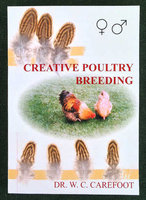Bellsouth Poultry Equipment Poultry Information Learning Resource Sheets Genetics Terminology
Genetics Terminology

Poultry Genetics Terminology can be confusing, so let's look at some definitions of terms, commonly used in genetics.
Chromosomes have been called the basic building blocks of life. The chromosomes are molecules of DNA (short for Dioxyriboneuclaic Acid). These chromosomes reside at the centre of each cell. Each cell in the body contains a complete set of these chromosomes.
There are two types of chromosomes in the cells. The first of these are the AUTOSOMAL chromosomes. These chromosomes determine the BODY of the bird (from the word soma meaning body).
The second type of chromosome is the SEX CHROMOSOMES. These obviously determine the sex of the bird. They also carry a large amount of other information besides the sex of the bird.
In the fowl the male bird has 38 pairs of AUTOSOMAL chromosomes and 1 pair of SEX chromosomes making 39 pairs in all.
The female bird has 38 pairs of AUTOSOMAL chromosomes and ONE ONLY SEX chromosome.
In the reproductive organs the pairs of chromosomes split up and so in the male the sperm carries 39 single chromosomes.
The female has however two different types of reproductive cells. When these cells split to form egg cells the single sex chromosome ends up in only one of the egg cells. This means that one egg will have 38 single AUTOSOMAL chromosomes and one SEX chromosome while the other egg will have 38 AUTOSOMAL chromosomes and NO SEX chromosomes.
This means that when the egg and the sperm unite to form a ZYGOTE or fertilized egg there will be two types of zygote formed.
One of these will be formed by the union of 38 AUTOSOMALchromosomes and one SEX chromosome from the male with 38 AUTOSOMAL chromosomes and one SEX chromosome from the female. The resultant fertilized egg will have 39 pairs of chromosomes and so will be a male. The other union will be 38 AUTOSOMAL chromosomes and one SEX chromosome from the male with 38 AUTOSOMAL chromosomes and no SEX chromosome from the female. This fertilized egg will be female.
All this has two important ramifications:
FIRSTLY, it is the female which determines the sex of the offspring.
SECONDLY, The female chicks have less genetic input from their mothers. This is where the expression SEX-LINKED is derived from. This is very important . The genetic material carried on the sex chromosome has a different effect depending on the sex of the bird. If the bird is a female, all the information on the sex chromosome is contributed by the father, as there is no sex chromosome input from the mother.
On the other hand if the bird is a male the information on the sex chromosomes comes from two sources, that is both the mother and the father, and so both parents influence the result.
This effect can be put to good use but only on those characteristics specifically confined to the sex chromosomes. In the case of the AUTOSOMAL genes the progeny are always the result of a blending of the genetic information.
This brings us to the actual unit of heredity called a gene. These genes are carded on the chromosomes in great numbers. Genes in combination or singly effect all the characteristics of the bird. The genes in combination with the environment produce the bird we see. The bird we see is called the PHENOTYPE. The bird we are actually interested in is the way it will breed. This is called the GENOTYPE.
I mentioned before that the bird is the result of blending of the genetic material. This blending is not like the mixing of two pots of paint,ie blue and yellow mix to make green, but is more like a sorting process. This sorting was described by Mendel and is called the Mendelian Theory of Heredity.
Mendel first experimented with peas. He crossed tall peas and short peas. The interesting thing to him was that all the offspring were of intermediate height. So he said that the tall peas were DOMINANT to the short peas.
The opposite was that the short peas were RECESSIVE to the tall peas. He then crossed these offspring with each other (sort of a brother sister mating) and found that the ofspring from these were of the following types.
25% were tall, 50% were intermediate, and 25% were short. Now if all the tall ones were bred together they produced only tall showing that they were pure and had no short genes. These were called HOMOZYGOUS or purebred for the tall genes.
If all the short ones were bred together they produced only short so these also were HOMOZYGOUS except for the short gene.
If the 50% intermediate were bred together then they produced 25% tall, 50% intermediates and 25% shorts just like the first intermediated did. These were called HETEROZYGOUS, impure, or if you like crossbreds.
The building blocks which make up the cells and carry the information which controlles the growth of the animal.
What the bird looks like on the outside.
Dominant
Homozygous
Pure for a particular gene.
Heterozygous



